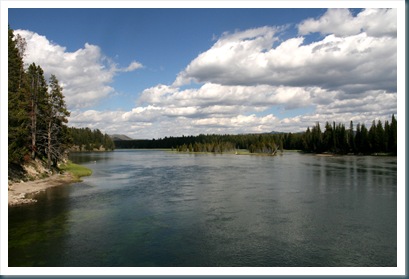Fishing Bridge Campground packs everyone in very tightly. Campers are staggered and there is very little room between sites. They only allow hard-sided campers here and are very strict about outside-food preparation and trash. They have bear-proof trash containers and you are not allowed to leave anything food-related outside your camper at night—even grills. Once a bear is accustomed to eating human food, it can become aggessive and must be put down. So they say not to feed the bears as “A fed bear is a dead bear!” We saw no bears, but did have a buffalo wander through the campground one morning. We were in the F Loop, while Matt and Alice were in the D Loop. Each loop was separated by a wooded area and they had constructed wooden tee-pees in each of these for the children to play in.
We selected Fishing Bridge as it is the one campground that has full hook-ups (water, electric and sewer). Matt and Alice’s 12-year old dog, Cosmo, needs the air on if it gets too hot. Notice the ramp that Matt has constructed to help get Cosmo back in their fifth-wheel.
We did not need to run the air while at Yellowstone, but did turn our furnaces and heaters on. The nights got down in the high 30’s and low 40’s. The days warmed up with the sun and we usually got away wearing light jackets. Alice and I spent Tuesday morning doing laundry and such, Matt washed his truck and camper and Hank drove up by the lake to get a phone signal to do some brick business. That afternoon, Hank desperately wanted to fish in the Yellowstone River and he and Matt tried their luck in a couple of spots, while Alice and I relaxed by the riverside. No fish were caught, but the guys were just happy to say they had fished the Yellowstone!
We ate dinner at the Lake Lodge—in fact, we ate there twice. Loved their turkey dinners and the view of the lake with the sun going down.
On Wednesday, we drove up to the Lake area, overlooking Yellowstone Lake. This was the place Hank had been going every morning to get phone signal to complete his business calls. Yellowstone Lake is North America’s largest mountain lake, being some 20 miles long and 430 feet deep at its deepest point. The average depth is 140 feet. The average August surface temperature is 60 degrees, while the bottom temperature never rises above 42 degrees. Swimming is discouraged even where not prohibited as such cold waters can cause potentially fatal hypothermia within mere minutes. We wondered how the water stays so cold with all the hot springs and geysers that are constantly running into it.
We then went to see the Mud Volcano region. This area is very bleak and smells like rotten eggs, but was still fascinating. The microorganisms living in the hot water eat the sulfur contained in the soil and create sulfuric acid. As it evaporates, it becomes hydrogen sulfide gas—that’s what you smell. The acid basically eats up the surrounding rock, creating the mud found here.
We saw 3 baby deer up in the hills above.
And we continued to see many trees with bark scraped off. Those with bark missing alone have been rubbed by buffalo or elk. But, those with claw marks have been rubbed by bears or grizzlies to sharpen their claws.
We stopped to take some pictures from Fishing Bridge, right at the bottom of our campground. The bridge was closed to fishing in 1973 and is now one of the best wild trout spawning areas anywhere.
Matt and Alice joined us for spaghetti in our coach. We shared a bottle of the Boisique that Bob and Pam had given us in Idaho—delicious!
Hank and I both loved Yellowstone. He was impressed by the large numbers of wildlife we witnessed. We saw bald eagles, coyote, buffalo (or bison), elk, osprey, mule deer, trumpeter swans, white pelicans and antelope. Hank and Alice got to see 2 grizzlies running back into the woods when Matt and I were at a separate viewing area. We did not see any bear, wolves or moose, but understand this might be the wrong time of year for easy sighting. I loved the park because of the ever-changing scenery and the large number of steaming geysers and springs. We also learned that Yellowstone is one of the most seismically active areas in the Intermountain West. Approximately 2000 earthquakes occur each year here; most are not felt. There’s lots going on beneath your feet! Here are a few more pictures from this most special place.
Next, on to Grand Teton National Park--






































Hi, it's a very great blog
ReplyDeleteI could tell how much efforts you've taken on it.
Keep doing!